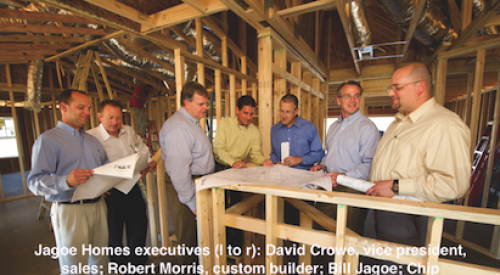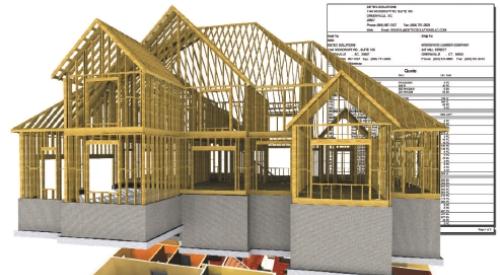|
 |
With proper planning, your company can implement scaleable operations built to make the most of opportunities for incremental and even geographic growth.
Ways to GrowBuilders who choose a growth trajectory have several ways to achieve it. For larger builders, going from private to publicly held is one way — an option chosen by many of the rarified Supernovas and Masters of the Universe identified each year in Professional Builders' Giant 400.
Many in this class size have also grown through mergers and acquisitions. Some larger builders have taken on franchising; Arthur Rutenberg Homes was an early adapter of this business model. As Professional Builder Senior Editor Bill Lurz said in November 2003: "Large privates see it as a way to grow, and small local builders see a franchise affiliation as a way to garner some of the attributes of size."
An option for small- to medium-sized builders — the bulk of the industry — is to open a division in a different geographic area. But before attempting that sort of growth, builders must learn to manage organic growth within the organization to insure that what they bring to another market is worth duplicating.
Manage Internal GrowthThe skills required to manage growth for maximum efficiency, profitability and quality vary depending on whether a builder does 10, 250 or 500 homes a year.
|
|
|
"It’s like all of a sudden the light bulb goes on for the home builder: ‘I didn’t realize there was this paradigm ... . If I had only known, I wouldn’t have expanded as fast as I had.’"- Jack H. Willenbrock |
"It's in that transitional zone that companies could fail," Willenbrock says, "because they grow before their managerial proficiency has increased to take the additional output."
Is there a specific volume or revenue point at which this transition occurs?
"We purposely kept that generic," says Willenbrock, "because we didn't want to get clouded with the idea of the number of housing units per year or the dollar volume per year, because it varies so much between a tract builder that's building entry-level houses and a custom builder that's building McMansions."
But it should be fairly clear to a builder when things need to change. Systems break down, warranty calls increase and staff morale falters. Bill and Scott Jagoe, brothers and co-founders of Jagoe Homes in Owensboro, Ky., both recall saying, "The company was managing us!" as they spoke at a workshop they taught entitled, "Process Your Business and Compete with The Giants," at this year's International Builders' Show.
Jagoe Homes, a mid-sized builder with 350 closings in 2006, was having serious growing pains a few years back. Sales rose, but processes, product and geographic strategy were not cohesive. Margins increased modestly, but overhead rose disproportionately resulting in decreased profits. Starts per superintendent increased, but the supers were getting burned out. Office staff increased too fast to manage effectively. And worst of all, on-time closings declined.
They made the decision to process their business because of "the frustration level of not being able to create efficiencies," says Scott Jagoe. "We weren't able to respond quickly to opportunities that were out there."
 There is a relationship between builder’s management proficiency and its ability to generate construction output; there are plateaus when a balance exists. During transition, managerial proficiency must increase if a builder wants to be prepared for the next range of construction output. |
In his research paper, "The Leadership/Management Growth Model: A Dynamic Framework for Understanding Construction Management and Production in the Homebuilding Industry," Willenbrock notes management systems as one measure of managerial proficiency. He identifies planning, quality, control and customer relations as four management systems (broken down further into 10 subsystems — see table below) that provide the tools and techniques to properly lead and manage a home-building organization.
"I present this in a workshop format," says Willenbrock of his leadership/management growth model. "It's like all of a sudden the light bulb goes on for the home builder: 'I didn't realize there was this paradigm that you can look at. If I had only known, I wouldn't have expanded as fast as I had.'"
Prepare for TransitionCompanies must be nimble to take on more work without going through a rushed, tumultuous transition that wreaks havoc on its resources.
"The transition period often results in an uncomfortable experience for the individuals within the firm," says Willenbrock. "It generally causes interpersonal conflicts because of new expectations and higher anticipated efficiencies."
And if they are dealing with ineffective processes and outmoded technology, their frustration will be that much worse. "The problem with most of the builders in Florida that really struggled last year," says Bob Whitten, a partner in the Orlando, Fla., office of SMA Consulting, a financial and management consultancy for the building industry, "is that they grew revenue in 2004 and 2005 without growing the requisite system to support the revenue. Then all sorts of things started to cave in."
Whitten made his comments during a workshop, "Ten Secrets to Growing Your Company and Improving Profitability, Even in a Down Market," at IBS this year. He says the biggest mistake home builders make is to sell more homes than they can build — especially in a down market and with high cycle times.
"When you understand that it takes discipline," says Whitten, "when you understand that it takes systems, consistency of product and approach for you to truly grow and sustain your growth in your top line revenues, that's when you'll be prepared to grow your company."
Keep an Eye on the NumbersWhitten says revenue growth is only sustainable when your current operations are under control and your gross profit margin is level.
"We're looking for a 25 percent gross profit margin for a production home builder in this country," Whitten says. "It's the single most important benchmark for a builder."
He tells the story of a builder in Detroit, a market he says has been about the worst market in the country for the last two or three years. "They survived because they had a 25 plus percent gross profit margin ... that allowed them to service a tremendous downturn. They had efficiencies in their systems, and those efficiencies allowed them to survive.
"Even if your volume is going to be 50 percent in 2006 and 2007 of what it was the year before," Whitten adds, "you can still grow your company by growing in efficiency." Whitten advises builders to pay close attention to operational numbers — superintendent costs, warranty expenses, and customer satisfaction reports — before gearing up for growth (See "Benchmarks for Home Builders," page 32).
"If you don't know what your customers are saying about you," Whitten says, "it's like winking at a girl in the dark."
If customers aren't happy with your product and service at current production levels, it's certainly not the time to produce unsatisfactory work at a higher volume. Keep tabs on the quality of construction and customer satisfaction so you can measure whether you are indeed being more efficient in your operations — not just producing shoddy homes at a snappy pace.
Efficient Processes and ProceduresJagoe Homes needed to weed out inefficiencies in its operations. It began documenting its non-construction related processes. Of the 237 processes identified, 137 were "non-value added" — meaning there was no real benefit to them.
The Jagoes used consultants to help develop repeatable processes, evaluate staffing levels and measure performance. And when they didn't find a software program to meet their needs, they developed a Web-based product, Dynami, which helps them monitor and interpret various activities within the company and evaluate how to best extract efficiency and profit from them. Dynami Solutions, now a subsidiary of Jagoe Homes, made its debut at this year's IBS. The company helps mid-market builders improve their company's operational and financial performance.
Tom Bradbury is the former head of Colony Homes, a company he sold to KB Home in March 2003. Colony closed 2,100 homes annually while achieving a 20 percent profit margin. It similarly went through the exercise of documenting and standardizing more than 200 processes.
"It gave consistency throughout the company in the way you do your job," Bradbury says. "That's a big deal when you start going in other markets." Colony Homes had divisions in Raleigh and Charlotte, N.C., and Atlanta. When he sold Colony Homes he retained the rights to the software and process model technologies it developed and launched SMART Builder Solutions, a system he markets to home builders.
Colony had a process for pricing its houses to market. The managers looked at every community within five miles and documented what and how many of a particular product was for sale, the price per foot, its features and the like. They also noted how many houses these competitors were selling a month. "Working backward from that," says Bradbury, "we priced to get a certain velocity."
But pricing to market doesn't change your costs. Bradbury had to route out inefficiencies in the internal process and externally with the trades.
"The fact that we were pricing the market, everything was pre-sold," says Bradbury. "Most of the time when builders grow, they grow their overhead before they grow their revenue. Doing the sales backlog before we add the overhead was the most effective way we found to grow profitably."
Efficiencies Build Economies of ScaleOnce processes are in place, you can clearly identify what's needed to produce a certain quantity of product. Scott Jagoe shares an example. When it takes you 100 days to build a home, you can build 3.65 homes in a year. But if you get rid of inefficiencies and can build a home in 80 days, you can build 4.56 homes without adding additional staff or putting in extra hours. Streamlined processes allow for a more efficient operation. Plus, you can contract and expand to correspond with changes in the market.
 |
| "Everything we did at an operating level of 500 to 600 units creates processes scalable up to 2,500 to 3,000 units." — Mark Upton |
Many processes require technology — the use of computers, software, phones, PDAs and the like — to be implemented efficiently. There are many software and hardware options, but many builders, like Jagoe and Colony Homes mentioned above, have created systems suited to their own needs.
"Most of the software we use is proprietary — things we've built for planning, scheduling, budgeting, purchasing all the way through construction," says Steve Wall, president of Arlington, Texas-based Wall Homes.
Flexible SystemsThe selection of technology is not a once and forever decision. Technology is always changing, but more importantly, a builder's needs change over time, especially as it grows.
"We always felt that systems and technology were key to keeping up with our growth," says Barry Frey, managing partner of America's First Homes, a builder in Bonita Springs, Fla. that produced 1,123 homes in 2006. "So we invested pretty heavily in some systems."
After a few false starts, the company found a database system that functions well, suits their needs, and can now grow with the company.
Efficient Organizational Structure and StaffingBefore adding headcount, consider areas where responsibilities are being duplicated or there might be inefficient use of staff time.
| "A pre-construction meeting ... was to make sure sales didn’t make a mistake. Otherwise, it has no value to anybody." — Bill Jagoe |
 |
The problem was their supers were spending two or three hours in construction meetings — time that could be spent working on houses.
"A pre-construction meeting, in my opinion, was to make sure sales didn't make a mistake," says Bill Jagoe. "Otherwise, it has no value to anybody."
"The strategy there was that we also had to train our salespeople on how to read plans and understand what specs are," Scott Jagoe says, so that it wasn't necessary for the superintendent to be there.
Hire Sooner — Not LaterOnce a manager evaluates operations and it is determined that he or she is indeed running a tight ship, it may be time to add staff to produce at a higher level.
"Hire earlier than your gut tells you," says Upton. "If you hire too late to get the right person, or he or she doesn't have proper training, it can really hurt everybody on your team. Overhead is so important to watch within a home builder, so you have to be very careful. But it's worth taking the risk.
"Even though [your staff is] very streamlined and efficient, you don't want to burn them out."
You want the right person who is well-trained and can be relied on to pull his or her weight at crunch time. Willenbrock, a judge for the 2005 National Housing Quality Awards, marveled at Pulte Homes' commitment to this concept when they won gold.
"They hired something like 700 or 800 new college graduates the year before we interviewed them," Willenbrock says, "because they knew that they were going to expand and they were willing to invest in the future. I had never heard of a company doing that before: 'We don't need them now, but we're going to put them with a team of experienced people in our branch offices, so when the expansion occurs, they are ready to jump in.' That's the kind of thinking that I think has to take place."
Invest in GrowthThe old adage is you have to spend money to make money. And you do have to invest money, time and thought in making strategic decisions that will gear up your company for growth.
"Growth can present some real challenges," says Frey, "and you have to go in with your eyes open. It's an investment, and you've got to dedicate the resources to it, or it will take you longer to get up to speed than it really should."
| Planning Systems | Quality Systems | Control Systems | Customer Systems |
| • Business Planning | • Quality Management | • Cost Estimating | • Trade Contractor/Supplier Partnering |
| • Office Management | • Cost Accounting | ||
| • Cost Control | •Customer Care Program | ||
| • Scheduling | |||
| • Safety Management | |||
| MANAGEMENT MUST IMPLEMENT an efficient system of procedures, tools and techniques to properly lead and manage a home building organization. | |||
|













